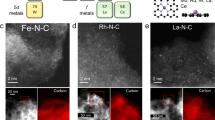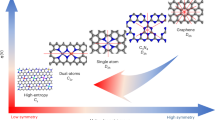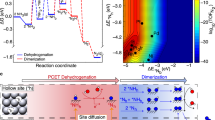Abstract
Transition metal nitride (TMN-) based materials have recently emerged as promising non-precious-metal-containing electrocatalysts for the oxygen reduction reaction (ORR) in alkaline media. However, the lack of fundamental understanding of the oxide surface has limited insights into structure–(re)activity relationships and rational catalyst design. Here we demonstrate how a well-defined TMN can dictate/control the as-formed oxide surface and the resulting ORR electrocatalytic activity. Structural characterization of MnN nanocuboids revealed that an electrocatalytically active Mn3O4 shell grew epitaxially on the MnN core, with an expansive strain along the [010] direction to the surface Mn3O4. The strained Mn3O4 shell on the MnN core exhibited an intrinsic activity that was over 300% higher than that of pure Mn3O4. A combined electrochemical and computational investigation indicated/suggested that the enhancement probably originates from a more hydroxylated oxide surface resulting from the expansive strain. This work establishes a clear and definitive atomistic picture of the nitride/oxide interface and provides a comprehensive mechanistic understanding of the structure–reactivity relationship in TMNs, critical for other catalytic interfaces for different electrochemical processes.
This is a preview of subscription content, access via your institution
Access options
Access Nature and 54 other Nature Portfolio journals
Get Nature+, our best-value online-access subscription
$32.99 / 30 days
cancel any time
Subscribe to this journal
Receive 12 print issues and online access
$259.00 per year
only $21.58 per issue
Buy this article
- Purchase on SpringerLink
- Instant access to full article PDF
Prices may be subject to local taxes which are calculated during checkout





Similar content being viewed by others
Data availability
The data supporting the findings of this study are included in the published article and its Supplementary Information or available from the corresponding authors on request. Source data are provided with this paper.
References
Debe, M. K. Electrocatalyst approaches and challenges for automotive fuel cells. Nature 486, 43–51 (2012).
Shao, M., Chang, Q., Dodelet, J.-P. & Chenitz, R. Recent advances in electrocatalysts for oxygen reduction reaction. Chem. Rev. 116, 3594–3657 (2016).
Yarlagadda, V. et al. Boosting fuel cell performance with accessible carbon mesopores. ACS Energy Lett. 3, 618–621 (2018).
Jaganmohan, M. Mine production of platinum worldwide from 2010 to 2021. Statista https://www.statista.com/statistics/1170691/mine-production-of-platinum-worldwide/ (2024).
Lu, S., Pan, J., Huang, A., Zhuang, L. & Lu, J. Alkaline polymer electrolyte fuel cells completely free from noble metal catalysts. Proc. Natl Acad. Sci. USA 105, 20611–20614 (2008).
Yang, Y. et al. Electrocatalysis in alkaline media and alkaline membrane-based energy technologies. Chem. Rev. 122, 6117–6321 (2022).
Ni, W. et al. An efficient nickel hydrogen oxidation catalyst for hydroxide exchange membrane fuel cells. Nat. Mater. 21, 804–810 (2022).
Zhao, Q., Yan, Z., Chen, C. & Chen, J. Spinels: controlled preparation, oxygen reduction/evolution reaction application, and beyond. Chem. Rev. 117, 10121–10211 (2017).
Hong, W. T. et al. Toward the rational design of non-precious transition metal oxides for oxygen electrocatalysis. Energy Environ. Sci. 8, 1404–1427 (2015).
Wang, Y., Li, J. & Wei, Z. Transition-metal-oxide-based catalysts for the oxygen reduction reaction. J. Mater. Chem. A 6, 8194–8209 (2018).
Liang, Y. et al. Co3O4 nanocrystals on graphene as a synergistic catalyst for oxygen reduction reaction. Nat. Mater. 10, 780–786 (2011).
Tong, Y. et al. A bifunctional hybrid electrocatalyst for oxygen reduction and evolution: cobalt oxide nanoparticles strongly coupled to B,N-decorated graphene. Angew. Chem. 56, 7121–7125 (2017).
Gorlin, Y., Chung, C. J., Nordlund, D., Clemens, B. M. & Jaramillo, T. F. Mn3O4 supported on glassy carbon: an active non-precious metal catalyst for the oxygen reduction reaction. ACS Catal. 2, 2687–2694 (2012).
Stoerzinger, K. A., Risch, M., Han, B. & Shao-Horn, Y. Recent insights into manganese oxides in catalyzing oxygen reduction kinetics. ACS Catal. 5, 6021–6031 (2015).
Wang, Y. et al. Synergistic Mn–Co catalyst outperforms Pt on high-rate oxygen reduction for alkaline polymer electrolyte fuel cells. Nat. Commun. 10, 1506 (2019).
Zhou, Y. et al. Revealing the dominant chemistry for oxygen reduction reaction on small oxide nanoparticles. ACS Catal. 8, 673–677 (2018).
Yang, Y. et al. Octahedral spinel electrocatalysts for alkaline fuel cells. Proc. Natl Acad. Sci. USA 116, 24425–24432 (2019).
Yang, Y. et al. Epitaxial thin-film spinel oxides as oxygen reduction electrocatalysts in alkaline media. Chem. Mater. 33, 4006–4013 (2021).
Bredar, A. R C. et al. Oxygen reduction electrocatalysis with epitaxially grown spinel MnFe2O4 and Fe3O4. ACS Catal. 12, 3577–3588 (2022).
Zheng, J. et al. Recent advances in nanostructured transition metal nitrides for fuel cells. J. Mater. Chem. A 8, 20803–20818 (2020).
Wang, H. et al. Transition metal nitrides for electrochemical energy applications. Chem. Soc. Rev. 50, 1354–1390 (2021).
Chen, P. et al. Metallic Co4N porous nanowire arrays activated by surface oxidation as electrocatalysts for the oxygen evolution reaction. Angew. Chem. 54, 14710–14714 (2015).
Walter, C. et al. A molecular approach to manganese nitride acting as a high performance electrocatalyst in the oxygen evolution reaction. Angew. Chem. 57, 698–702 (2018).
Yang, Y., Zeng, R., Xiong, Y., Disalvo, F. J. & Abruña, H. D. Cobalt-based nitride-core oxide-shell oxygen reduction electrocatalysts. J. Am. Chem. Soc. 141, 19241–19245 (2019).
Luo, J. et al. Limitations and improvement strategies for early-transition-metal nitrides as competitive catalysts toward the oxygen reduction reaction. ACS Catal. 6, 6165–6174 (2016).
Miura, A. et al. Nitrogen-rich manganese oxynitrides with enhanced catalytic activity in the oxygen reduction reaction. Angew. Chem. 55, 7963–7967 (2016).
Tian, X. L. et al. Formation of a tubular assembly by ultrathin Ti0.8Co0.2N nanosheets as efficient oxygen reduction electrocatalysts for hydrogen–/metal–air fuel cells. ACS Catal. 8, 8970–8975 (2018).
Yuan, Y. et al. Zirconium nitride catalysts surpass platinum for oxygen reduction. Nat. Mater. 19, 282–286 (2020).
Zeng, R. et al. Non-precious transition metal nitrides as efficient oxygen reduction electrocatalysts for alkaline fuel cells. Sci. Adv. 8, eabj1584 (2022).
Deng, Y.-P. et al. Dynamic electrocatalyst with current-driven oxyhydroxide shell for rechargeable zinc–air battery. Nat. Commun. 11, 1952 (2020).
Yang, H., Al-Brithen, H., Trifan, E., Ingram, D. C. & Smith, A. R. Crystalline phase and orientation control of manganese nitride grown on MgO(001) by molecular beam epitaxy. J. Appl. Phys. 91, 1053–1059 (2002).
Sun, W. et al. Thermodynamic routes to novel metastable nitrogen-rich nitrides. Chem. Mater. 29, 6936–6946 (2017).
Leineweber, A., Niewa, R., Jacobs, H. & Kockelmann, W. The manganese nitrides η-Mn3N2 and θ-Mn6N(5 + x): nuclear and magnetic structures. J. Mater. Chem. 10, 2827–2834 (2000).
Timoshenko, J. & Roldan Cuenya, B. In situ/operando electrocatalyst characterization by X-ray absorption spectroscopy. Chem. Rev. 121, 882–961 (2021).
Wang, M. & Feng, Z. Pitfalls in X-ray absorption spectroscopy analysis and interpretation: a practical guide for general users. Curr. Opin. Electrochem. 30, 100803 (2021).
Wei, C. et al. Approaches for measuring the surface areas of metal oxide electrocatalysts for determining their intrinsic electrocatalytic activity. Chem. Soc. Rev. 48, 2518–2534 (2019).
Wang, L. et al. Tunable intrinsic strain in two-dimensional transition metal electrocatalysts. Science 363, 870–874 (2019).
Li, H. et al. Oxidative stability matters: a case study of palladium hydride nanosheets for alkaline fuel cells. J. Am. Chem. Soc. 144, 8106–8114 (2022).
Davis, R. E., Horvath, G. L. & Tobias, C. W. The solubility and diffusion coefficient of oxygen in potassium hydroxide solutions. Electrochim. Acta 12, 287–297 (1967).
Fan, J. et al. Bridging the gap between highly active oxygen reduction reaction catalysts and effective catalyst layers for proton exchange membrane fuel cells. Nat. Energy 6, 475–486 (2021).
Yang, Y. et al. High-loading composition-tolerant Co–Mn spinel oxides with performance beyond 1 W/cm2 in alkaline polymer electrolyte fuel cells. ACS Energy Lett. 4, 1251–1257 (2019).
Noda, N. et al. Highly oxidizing aqueous environments on early Mars inferred from scavenging pattern of trace metals on manganese oxides. J. Geophys. Res. Planets 124, 1282–1295 (2019).
Dasog, M. Transition metal nitrides are heating up the field of plasmonics. Chem. Mater. 34, 4249–4258 (2022).
Wei, J. et al. Probing the oxygen reduction reaction intermediates and dynamic active site structures of molecular and pyrolyzed Fe–N–C electrocatalysts by in situ Raman spectroscopy. ACS Catal. 12, 7811–7820 (2022).
Nørskov, J. K. et al. Origin of the overpotential for oxygen reduction at a fuel-cell cathode. J. Phys. Chem. B 108, 17886–17892 (2004).
Mavrikakis, M., Hammer, B. & Nørskov, J. K. Effect of strain on the reactivity of metal surfaces. Phys. Rev. Lett. 81, 2819–2822 (1998).
Han, J. W. & Yildiz, B. Mechanism for enhanced oxygen reduction kinetics at the (La,Sr)CoO3−δ/(La,Sr)2CoO4+δ hetero-interface. Energy Environ. Sci. 5, 8598–8607 (2012).
Ma, D. et al. Effect of lattice strain on the oxygen vacancy formation and hydrogen adsorption at CeO2(111) surface. Phys. Lett. A 378, 2570–2575 (2014).
Zeng, Y. et al. Surface reconstruction of water splitting electrocatalysts. Adv. Energy Mater. 12, 2201713 (2022).
Mefford, J. T. et al. Correlative operando microscopy of oxygen evolution electrocatalysts. Nature 593, 67–73 (2021).
Ravel, B. & Newville, M. ATHENA, ARTEMIS, HEPHAESTUS: data analysis for X-ray absorption spectroscopy using IFEFFIT. J. Synchrotron Radiat. 12, 537–541 (2005).
Cueva, P., Hovden, R., Mundy, J. A., Xin, H. L. & Muller, D. A. Data processing for atomic resolution electron energy loss spectroscopy. Microsc. Microanal. 18, 667–675 (2012).
Yang, Y. et al. In situ X-ray absorption spectroscopy of a synergistic Co–Mn oxide catalyst for the oxygen reduction reaction. J. Am. Chem. Soc. 141, 1463–1466 (2019).
Kresse, G. & Furthmüller, J. Efficient iterative schemes for ab initio total-energy calculations using a plane-wave basis set. Phys. Rev. B 54, 11186 (1996).
Kresse, G. & Furthmüller, J. Efficiency of ab-initio total energy calculations for metals and semiconductors using a plane-wave basis set. Comput. Mater. Sci. 6, 15–50 (1996).
Acknowledgements
This work was supported by the Center for Alkaline Based Energy Solutions (CABES), part of the Energy Frontier Research Center (EFRC) programme supported by the US Department of Energy under Grant DE-SC-0019445 (R.Z., H.L., Z.S., L.X., W.X., H.W., Q.L., M.M., D.M., H.D.A.). This work made use of TEM facilities at the Cornell Center for Materials Research (CCMR), which are supported through the National Science Foundation Materials Research Science and Engineering Center (NSF MRSEC) programme (DMR1719875, Z.S., D.M.) and PARADIM, an NSF MIP (DMR-2039380, Z.S., D.M.). This research used resources of the National Energy Research Scientific Computing Center, a DOE Office of Science User Facility supported by the Office of Science of the US Department of Energy under Contract DE-AC02-05CH11231 (L.X., M.M.) using NERSC award BES-ERCAP0022773. The in situ Raman measurement is supported by the Air Force Office of Scientific Research under award numbers FA9550-18-1-0420 (J.M, T.L.) This work is based on research conducted at the Center for High-Energy X-ray Sciences (CHEXS), which is supported by the National Science Foundation (BIO, ENG and MPS Directorates) under award DMR-1829070 (C.J.P.). We thank F. J. DiSalvo for helpful suggestions on material synthesis. We are also grateful to J. Grazul and M. Thomas at CCMR for the help in STEM training. We appreciate the assistance of Cornell High Energy Synchrotron Source staff scientists at the PIPOXS beamline, L. Debefve and K. D. Finkelstein.
Author information
Authors and Affiliations
Contributions
R.Z., H.L. and H.D.A. conceived and designed the experiments. R.Z. and H.L. performed sample preparation, XRD, XAS and X-ray photoemission spectroscopy characterization and the electrochemical measurements with assistance from H.W. Z.S. conducted STEM-EELS characterization and strain analysis, supervised by D.M. R.Z. and H.L. performed operando XAS characterization and data analysis with the help of W.X. and C.J.P. J.M. carried out in situ Raman spectroscopy characterization and data analysis, supervised by T.L. L.X. and M.M. conceived and designed the modelling work and L.X. performed the DFT calculations. R.Z. and H.L. carried out membrane electrode assembly testing with the help of Q.L. R.Z., H.L., Z.S., L.X., M.M. and H.D.A. wrote the paper. All of the authors discussed the results and commented on the paper.
Corresponding authors
Ethics declarations
Competing interests
The authors declare no competing interests.
Peer review
Peer review information
Nature Materials thanks the anonymous reviewers for their contribution to the peer review of this work.
Additional information
Publisher’s note Springer Nature remains neutral with regard to jurisdictional claims in published maps and institutional affiliations.
Supplementary information
Supplementary Information
Supplementary Figs. 1–38, Tables 1–5, Notes and Methods.
Supplementary Data 1
VASP optimized structures for adsorption on unstrained Mn3O4(001) surface, 5% expanded Mn3O4(001) surface and 5% compressed Mn3O4(001) surface.
Source data
Source Data Fig. 1
Density of states data plotted in Fig. 1a, XRD data plotted in Fig. 1b, XANES data plotted in Fig. 1c and EXAFS data plotted in Fig. 1d.
Source Data Fig. 2
Electrochemical data plotted in Fig. 2.
Source Data Fig. 3
XANES and EXAFS data plotted in Fig. 3a–d and Raman data plotted in Fig. 3e.
Source Data Fig. 4
In-plane strain data plotted in Fig. 4f.
Source Data Fig. 5
Gibbs free-energy data plotted in Fig. 5a and differential binding energy plotted in Fig. 5b.
Rights and permissions
Springer Nature or its licensor (e.g. a society or other partner) holds exclusive rights to this article under a publishing agreement with the author(s) or other rightsholder(s); author self-archiving of the accepted manuscript version of this article is solely governed by the terms of such publishing agreement and applicable law.
About this article
Cite this article
Zeng, R., Li, H., Shi, Z. et al. Origins of enhanced oxygen reduction activity of transition metal nitrides. Nat. Mater. 23, 1695–1703 (2024). https://doi.org/10.1038/s41563-024-01998-7
Received:
Accepted:
Published:
Issue date:
DOI: https://doi.org/10.1038/s41563-024-01998-7
This article is cited by
-
Modeling the impact of structure and coverage on the reactivity of realistic heterogeneous catalysts
Nature Chemical Engineering (2025)
-
The geometric-electronic coupled design of diatomic catalyst towards oxygen reduction reaction
Nature Communications (2025)
-
Locking interstitial hydrogen atoms in Pd metallenes for efficient oxygen reduction reaction
Nature Communications (2025)
-
Charge-polarized lanthanide coordination strategy enables activity-stability synergy in rare earth-tailored metallene electrocatalysts
Science China Materials (2025)
-
Heterojunction distortion engineering strain effect for selective 4-electron oxygen reduction
Science China Chemistry (2025)



